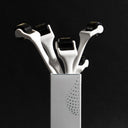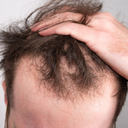A healthy scalp is the foundation of strong, vibrant hair. While genetics, diet, and overall health play key roles in hair growth, one often overlooked factor is scalp circulation. Scalp massage, a simple yet powerful practice, has been used for centuries to encourage relaxation and stimulate hair follicles.
By increasing blood flow, distributing natural oils, and reducing tension, regular massage can create the optimal environment for hair growth.
In this guide, we’ll explore effective scalp massage techniques, the science behind their benefits, and practical tips to help you incorporate them into your hair care routine, tailored for those in the UK.
Table of content
Key Takeaways
- Scalp massage may promote hair growth and hair regrowth by increasing blood flow to hair follicles and stimulating dermal papilla cells.
- Regular scalp massage (5–20 minutes daily) can improve hair thickness and scalp health.
- Research findings indicate that scalp massage may improve the growth rate of hair and increase thickness, with studies showing measurable benefits in both parameters.
- Techniques include circular motions, kneading, and using tools like scalp massagers or essential oils.
- Combining scalp massage with other treatments, like minoxidil, may enhance results.
- Research suggests moderate pressure is key to avoiding scalp irritation while maximising benefits.
- Does Scalp Massage Promote Hair Growth?
Yes, scalp massage may promote hair growth by increasing blood flow to hair follicles, stimulating dermal papilla cells, and relieve stress, which can contribute to hair loss.
Increased blood flow is a key factor in stimulating hair follicles and supporting hair growth. Regular scalp massages can also improve hair growth by enhancing hair thickness, leading to stronger hair.
Scalp massage helps by increasing circulation to the scalp, strengthening hair roots, and reducing scalp tension, all of which support the natural growth cycle of hair.
While these benefits are promising, most studies suggest that more large-scale research is needed to fully confirm the effects of scalp massage on new hair growth. For personalised advice, consult a UK-based dermatologist or trichologist.
Can Scalp Massage Encourage Hair Growth?
Scalp massage enhances blood circulation to the scalp, delivering essential nutrients and oxygen to hair follicles. A 2016 study by Koyama et al. found that a 4-minute daily scalp massage increased hair thickness in participants after 24 weeks, likely due to improved blood flow and stimulation of dermal papilla cells, which regulate hair growth cycles.
The study also suggests that the mechanical force applied during scalp massage transmits through the scalp skin, stimulating hair follicle cells and potentially activating signalling pathways involved in hair growth. Also, scalp massage can reduce stress hormones like cortisol, which are linked to hair loss conditions such as telogen effluvium.
Scientific Evidence
A 2019 study published in Dermatology and Therapy showed that standardised scalp massage led to increased hair density in men with androgenetic alopecia. The mechanical stress from massage may activate pathways that promote hair follicle activity, though results vary based on individual factors like genetics and consistency.
Massage treatment may also be beneficial for female pattern hair loss, a common cause of age-related hair thinning in women, as it can help manage decreased hair density and thickness. For tailored advice, consider consulting a trichologist, widely available in the UK.
Stimulate your scalp and support healthier, thicker-looking hair with the Scandinavian Biolabs Scalp Activation Derma Roller.
Shop the Scalp Activation Derma Roller in the UKAs your leading source for hair health information over the past 4 years, we never compromise on accuracy. When it comes to your health, you deserve information you can truly rely on - and earning your trust is our top priority.
Here's how Scandinavian Biolabs ensures every piece of content meets the highest standards of accuracy and integrity:
- Credentialed Experts: Our reviewers are actively practicing doctors and medical researchers
- Stringent Reviews: Content undergoes rigorous editing by subject specialists and review by a practicing doctor.
- Evidence-Based: We rely on well-established research from trusted scientific sources like peer-reviewed journals and health authorities.
- Full Transparency: Our editorial standards, writer credentials, reviewer credentials, correction process, and funding are all publicly documented.
- Independent Voice: While we do promote products, we operate in a vacuum to business operations. Our main goal is just an unwavering commitment to providing medically-sound guidance.
You can count on Scandinavian Biolabs to consistently deliver the trustworthy health information you deserve. Read our Editorial Standards.
The Role of Blood Circulation in Hair Growth
Blood circulation is fundamental to the health and growth of your hair. The scalp is rich in blood vessels that deliver oxygen and essential nutrients directly to hair follicles, fuelling the growth of new, healthier hair.
Hair follicles
When blood flow to the scalp is increased, hair follicles receive more of the nutrients they need to produce thicker, stronger strands. Regular scalp massage is a proven way to boost blood circulation in the scalp, which can lead to increased hair thickness and a noticeable reduction in hair loss.
In fact, research has shown that scalp massage can improve blood flow to the scalp by as much as 120% against the baseline, making a significant difference in the overall health and appearance of your hair. By making scalp massage a regular part of your routine, you can support your hair follicles and promote optimal hair growth.
Regular scalp massage may also help lower blood pressure by reducing stress and improving overall circulation, as supported by some studies.
Increased Hair Thickness: Can Scalp Massage Help?
Yes—scalp massage can help increase hair thickness by enhancing blood flow to the scalp, which in turn nourishes the hair follicles. When you massage your scalp, the blood vessels expand, allowing more oxygen and essential nutrients to reach the roots of your hair. This improved circulation can lead to healthier, thicker hair over time.
Blood flow
In addition to increasing blood flow, scalp massage helps to lower stress hormones in the body. Since high levels of stress are linked to hair loss, reducing stress through regular scalp massage can further support hair growth and help you maintain a thicker, fuller head of hair.
The process is entirely natural and can be easily incorporated into your daily routine, making it an accessible option for anyone in the UK looking to improve their hair’s appearance and health.
Mechanisms Behind Thicker Hair
Research indicates that scalp massage can influence the expression of certain genes associated with hair growth, such as BMP4 and NOGGIN, which play a role in the development and maintenance of hair follicles.
At the same time, scalp massage may help reduce the activity of genes linked to hair loss, like IL6. This dual action—stimulating growth-promoting genes while suppressing those related to hair loss—can result in thicker, more resilient hair.
Studies have shown that individuals who practice regular scalp massage often experience not only an increase in hair thickness but also a reduction in overall hair loss, making it a valuable addition to any hair care regimen.
What to Expect
If you’re considering scalp massage to improve hair thickness, it’s helpful to know what the experience involves. Many people in the UK choose to visit a qualified massage therapist or trichologist who specialises in scalp massage, ensuring that the technique is performed safely and effectively.
During a session, the therapist will use gentle, circular motions to massage the scalp, focusing on areas where tension and stress are most pronounced. This method not only promotes relaxation but also helps to stimulate the scalp and encourage hair growth.
Over time, with consistent scalp massage, you may notice your hair becoming thicker and healthier, as well as a general sense of well-being and reduced stress. Look for qualified therapists through UK organisations like the Federation of Holistic Therapists (FHT).
How Often Should You Massage Your Scalp for Hair Growth?
For optimal results, massage your scalp for 5–20 minutes daily. If that’s not feasible, aim for 3–4 times a week. Using your fingertips or natural oils can enhance circulation, nourish the scalp, and support healthier hair growth over time.
Creating a Scalp Massage Routine
Consistency is key. Daily scalp massages, even for as little as 5 minutes, can improve scalp health and hair thickness over time. For best results, aim for 10–20 minutes per session twice daily scalp massages, either in the morning or before bed. You can perform massages while shampooing, during a shower, or as a standalone routine with oils.
Incorporating body relaxation techniques and massage therapy into your routine can further support hair and scalp health. Focusing on the body’s overall wellness, including stress reduction and improved circulation, helps create the ideal environment for healthy hair growth.
Regular scalp massage may also help relieve chronic pain, such as tension headaches or persistent scalp discomfort, providing additional therapeutic benefits. Seeking professional massage therapy from qualified therapists, available at UK wellness clinics, can also provide therapeutic benefits for both your scalp and body.
Tips for Consistency
- Schedule it: Incorporate scalp massage into your daily hair care routine, such as after applying shampoo or conditioner.
- Use reminders: Set a phone alarm to ensure you don’t skip sessions.
- Combine with relaxation: Pair scalp massage with mindfulness or meditation to reduce stress, further supporting hair health.
What Are the Best Scalp Massage Techniques for Hair Growth?
Effective techniques include a simple scalp massage, such as circular motions, kneading, and tapping with fingertips, using moderate pressure to stimulate the scalp without causing irritation. When performing circular motions, use your fingertips to make small circles, which helps promote blood flow and relaxation.
Step-by-Step Scalp Massage Techniques
- Circular Motions: Use your fingertips to make small, firm circles across your entire scalp. Start at the hairline and gently massage towards the crown, covering all areas.
- Kneading: Gently pinch and lift the scalp with your fingers, moving it in a wave-like motion to stimulate subcutaneous tissue.
- Tapping: Lightly tap your scalp with your fingertips to increase blood flow without applying excessive pressure.
- Side-to-Side Movements: Place your hands on either side of your head and gently move the scalp back and forth to loosen tension.
Tips for Effective Technique
- Use moderate pressure to avoid scalp irritation or damage to hair follicles.
- Focus on areas prone to thinning, such as the crown or temples, but cover the entire scalp for balanced stimulation.
- Perform massages on a clean scalp to prevent buildup of oils or product residue.
- Avoid tight hairstyles to prevent hair damage and support the benefits of scalp massage.
What Tools Can Enhance Scalp Massage Effectiveness?
A traditional scalp massage involves the use of your fingertips only, but specialised scalp massager tools, brushes, and essential oil applicators can enhance massage effectiveness by improving stimulation, increasing blood flow, and promoting scalp health. These are widely available in the UK at retailers like Boots or Superdrug.
Recommended Scalp Massage Tools
The Scandinavian Biolabs Scalp Activation Derma Roller :
A handheld cosmetic tool with 540 high-grade stainless-steel microneedles (0.5 mm) designed for gentle scalp stimulation. Roll lightly across a clean, dry or damp scalp once weekly to start. Suitable for all hair types, it helps maintain a healthy-feeling, refreshed scalp.

- Manual Scalp Massagers: Handheld devices with soft silicone bristles stimulate the scalp without pulling hair. They’re ideal for use during shampooing.
- Electric Scalp Massagers: These vibrate to increase blood flow and are great for those with limited hand mobility.
- Jade or Gua Sha Combs: These smooth tools glide over the scalp, promoting circulation and reducing tension.
- Fingertip Brushes: Affordable and portable, these mimic finger movements for precise stimulation.
- Consult a Professional: For advanced scalp massage techniques, consider visiting a qualified massage therapist or trichologist at a UK wellness clinic for expert care and personalised recommendations.
How to Use Tools
- Apply gentle pressure and move tools in circular or linear motions.
- Clean tools regularly to prevent bacterial buildup.
- Combine with oils for added nourishment (see below for oil recommendations).
How Do Essential Oils Enhance Scalp Massage?
Essential oils like peppermint, rosemary, and lavender should be diluted with carrier oils before application to the scalp. Using carrier oils not only helps distribute the essential oils evenly but also nourishes the scalp and reduces the risk of irritation, enhancing the benefits of scalp massage by improving circulation and overall scalp health.
Regular scalp massage with essential oils can contribute to achieving luscious hair by supporting shine, strength, and overall hair vitality. These oils are available at UK retailers like Holland & Barrett or The Body Shop.
Best Oils for Scalp Massage
- Peppermint Oil: A 2014 study showed that peppermint oil increased hair growth in mice by stimulating blood flow and follicular activity.
- Rosemary Oil: Comparable to minoxidil in some studies, rosemary oil may improve hair thickness and reduce hair loss.
- Lavender Oil: Known for its calming effects, lavender oil reduces stress and may support scalp health.
How to Use Oils
- Dilute 3–5 drops of essential oil with 1 tablespoon of a carrier oil (e.g., coconut, jojoba, or argan oil).
- Apply the mixture to your scalp before or during massage.
- Massage for 5–10 minutes, then leave the oil on for 30 minutes before rinsing (optional).
Safety Note: Always perform a patch test to avoid allergic reactions. Avoid overuse, as excessive oil can clog pores.
Can Scalp Massage Replace Other Hair Loss Treatments?
Scalp massage complements but does not fully replace treatments like minoxidil or PRP therapy, as it addresses circulation and scalp health rather than underlying causes of hair loss. To maximise the benefits of scalp massage, consider taking breaks from chemical treatments, as this can help your hair respond more positively to improved scalp care.
Complementary Use with Treatments
- Minoxidil: Scalp massage can enhance minoxidil absorption by improving blood flow, potentially boosting its effectiveness.
- Platelet-Rich Plasma (PRP): Massage may support PRP by maintaining scalp health post-treatment.
- Nutritional Supplements: Pairing massage with biotin or other hair-supporting nutrients (available at Boots or Superdrug) can optimise results.
- Working with a Professional: A qualified massage therapist or trichologist can provide specialised scalp massage techniques for optimal results.
Limitations
Scalp massage is most effective for early-stage hair thinning or as a preventive measure, as it may help prevent hair loss by supporting healthy hair follicles. It may not address severe hair loss caused by genetics, hormonal imbalances, or medical conditions. Consult a UK-based dermatologist or trichologist for personalised advice.
FAQs
How Long Should Each Scalp Massage Session Last?
Sessions of 5–20 minutes are ideal. Start with 5 minutes daily and gradually increase to 10–20 minutes for optimal results, based on comfort and time availability.
Are There Risks from Too Much Head Massage?
Excessive pressure or over-massaging (beyond 20 minutes daily) may cause scalp irritation, redness, or damage to hair follicles. Use moderate pressure and stop if discomfort occurs.
Can Scalp Exercises Really Improve Circulation?
Yes, scalp exercises like massage or gentle stretching increase blood flow to the scalp, delivering nutrients to hair follicles and supporting a healthy growth environment.
How Long Does It Take to See Results from Scalp Massage?
Results vary, but studies suggest 12–24 weeks of consistent daily massage may lead to noticeable improvements in hair thickness and scalp health. Regular scalp massage can also help reduce dandruff by removing dead skin cells and supporting a cleaner, healthier scalp.
Can You Combine Scalp Massage with Other Treatments?
Yes, scalp massage pairs well with treatments like minoxidil, essential oils, or nutritional supplements to boost hair growth results. Research shows that a four minute scalp massage improves blood flow to hair follicles and can increase hair thickness over time when practiced consistently. You can perform the massage on either dry hair or after washing hair, as long as the scalp is clean and free of heavy product buildup.
When to Avoid Scalp Massages?
Skip massage if you’ve had a recent hair transplant or scalp procedure, have an active scalp infection, are in a severe seborrheic dermatitis or psoriasis flare, or have open cuts, sores, or sunburn on the scalp. When in doubt, check with a UK-based dermatologist or trichologist first.
Sources
-
Koyama T, Kobayashi K, Hama T, Murakami K, Ogawa R. (2016). Standardized Scalp Massage Results in Increased Hair Thickness by Inducing Stretching Forces to Dermal Papilla Cells in the Subcutaneous Tissue. Eplasty, 16, e8.
Read the study -
English RS Jr, Barazesh JM. (2019). Self-Assessments of Standardized Scalp Massages for Androgenic Alopecia: Survey Results. Dermatology and Therapy (Heidelb), 9(1), 167–178.
Read the study -
Soga H, Morita K, Arai K. (2014). Effects for Scalp Blood Flow and Properties from Scalp Massage. Journal of Society of Cosmetic Chemists of Japan, 48(2), 97–103.
Read the study -
Oh JY, Park MA, Kim YC. (2014). Peppermint Oil Promotes Hair Growth without Toxic Signs. Toxicological Research, 30(4), 297–304.
Read the study -
Panahi Y, Taghizadeh M, Tahmasbpour Marzony E, Sahebkar A. (2015). Rosemary Oil vs Minoxidil 2% for the Treatment of Androgenetic Alopecia: A Randomized Comparative Trial. Skinmed, 13(1), 15–21.
Read the study -
Top Doctors. (n.d.). Trichology – Medical Specialists. 85 Tottenham Court Road, London, W1T 4TQ.
Visit the page




